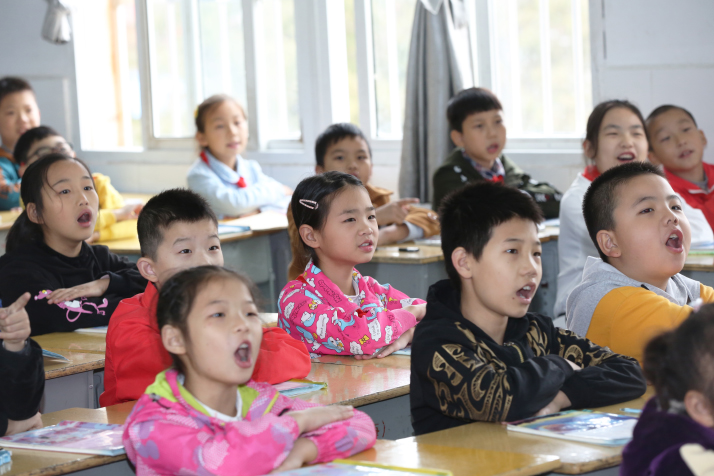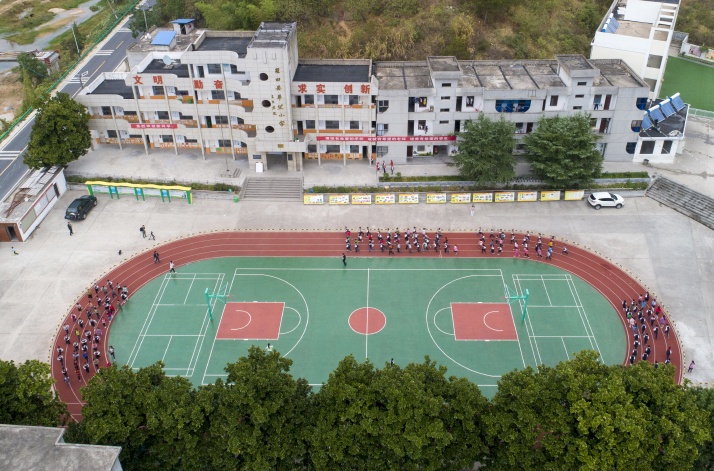|
||||||
|
||||||
| Home Nation World Business Opinion Lifestyle China Focus ChinAfrica Video Multimedia Columnists Documents Special Reports |
|
||||||
|
||||||
| Home Nation World Business Opinion Lifestyle China Focus ChinAfrica Video Multimedia Columnists Documents Special Reports |
| Nation |
| Lessons for Life |
| Pioneering project for rural children strengthens educational reform |
| By Xia Yuanyuan · 2019-11-11 · Source: NO.46 NOVEMBER 14, 2019 |
 Third graders in Jinzhai County Hope Primary School in east China's Anhui Province have a math class on October 16 (SHI GANG)
In her recent photographs with her little daughter, both of them wearing smart matching clothes in blue, Su Mingjuan looks affluent and confident. It's a far cry from her photograph in 1991, which became the face of China's largest charitable program Project Hope's drive for educational improvements in impoverished rural areas. In the iconic photo, Su, then 8, looks intently at the camera, a pencil gripped in her right hand. Something about the unsmiling, somber girl sitting in a rundown classroom in Jinzhai, a county in Anhui Province in east China, caught the attention of a visiting newspaper photographer from Beijing. The black and white photograph he took of her became one of the best-known photos of that time. Titled I Want to Go to School, the photo represented the campaign for education for all. Strangers were moved to contribute to her education and together with an added donation by Project Hope, Su, the daughter of a poor farmer, continued her education and in 2002 was admitted to Anhui University as a major in financial science. Today, she works at the Anhui branch of the Industrial and Commercial Bank of China, the largest bank in the world. She donates part of her salary for charitable work. "Without Project Hope, my life would have been completely different. It has changed my fate along with assisting millions of other poor families," Su told the media. Located in a mountainous area, Jinzhai, because of its remote location and poor transportation, was mired in poverty in the 1990s. Many of the local farmer families could not afford to send their children to school and the county faced a high school dropout incidence. Jinzhai was not alone. According to official statistics, in the 1987-88 school year more than 7 million primary and junior middle students dropped out of school, many because of poverty. Turning the tide To reverse that trend, in 1989, the Central Committee of the Communist Youth League of China and the China Youth Development Foundation (CYDF) decided to launch Project Hope, the first major program in China to raise funds to help students from low-income families to return to school and boost youth development. The first primary school under Project Hope opened in Jinzhai in 1991. Liao Guilin, Vice Principal of the Jinzhai County Hope Primary School, described what it was like nearly 30 years ago. "The school was a makeshift structure in a decrepit hall whose walls were of mud and windows were broken. The desks and benches were ramshackle," Liao told Beijing Review. The makeshift structure was rebuilt into a modern five-story building where the classrooms have hi-tech multimedia equipment. There are 900 students compared to the about 300 when it first started and nearly 50 teachers. Over the years, more than 1,000 students at the school have been sponsored by Project Hope, accounting for almost 20 percent of those who completed school. In the three decades, 500 children from impoverished families have received financial assistance from the project daily on average, according to the CYDF. "A better upbringing by receiving education brings hope to the children in poor families," Li Ning, former Deputy Secretary General of the CYDF, said. Liao echoed Li, saying, "Families that live in extreme poverty often see school as an unaffordable expense and this thinking is what creates a never-ending cycle. Poor people who grow up without education are less likely to send their children to school, which means the children remain trapped in poverty when they grow up because they are uneducated. Education can break the cycle of poverty."  Students do morning exercises at a school built with funding from Project Hope in Luotian County, central China's Hubei Province, on October 11 (XINHUA)
Education for poverty relief China's poverty alleviation policy highlights the importance of education. The government addresses poverty by enhancing the skills of the impoverished and improving their capacity for development so that poverty is not transmitted across generations. In 2017, when President Xi Jinping toured an impoverished village in Hebei Province in north China, he stressed the role of education as a key factor in poverty alleviation, saying, "Making sure children of impoverished families enjoy access to high-quality education is a fundamental solution to poverty." With China's economy developing rapidly over the past 40 years, the Central Government has increased investment in elementary education to make it compulsory and free. The year 2006 was a turning point for China's education reform. The revised Compulsory Education Law adopted that year put forward the idea of "balanced development of compulsory education." Subsequently, the government carried out a policy that would exempt students from paying for their textbooks and tuition and other miscellaneous fees during the nine-year compulsory education period. In addition, students from needy families would receive subsidies for their living expenses. Free compulsory education was first provided in rural areas before being implemented across the country. The new mission Now that the school dropout problem has been addressed, the mission of Project Hope schools has changed. "At this critical moment of poverty alleviation, the importance of talents in future rural vitalization cannot be overestimated. High-quality all-round education is crucial to shaking off poverty and tackling difficulties," Li said. Liao said the aim now is to provide better education to students. To narrow the quality gap with urban schools, Project Hope has trained over 114,000 rural primary school teachers. Extracurricular activities such as art, music, sports and science have been made available. The program has built playgrounds for sports, music and art classrooms, and computer labs to promote the comprehensive development of education in rural areas. As of 2018, Project Hope had raised over 15 billion yuan ($2.14 billion) and assisted over 5.9 million financially challenged rural students—primary, secondary as well as college students—and built 20,110 primary schools, 31,109 mini libraries and 6,236 kitchens. The schools financed by Project Hope are playing a vital role not only in enhancing the overall quality of education but also in promoting the poverty alleviation campaign, Liao said. Copyedited by Sudeshna Sarkar Comments to yanwei@bjreview.com |
|
||
About Us | Contact Us | Advertise with Us | Subscribe
|
||
| Copyright Beijing Review All rights reserved 京ICP备08005356号 京公网安备110102005860号 |